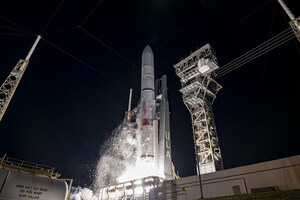United Launch Alliance Atlas V Rocket Successfully Launches NASA's Radiation Belt Storm Probes Mission
Atlas V and Delta IV Celebrate a Decade of Successful Launches
CAPE CANAVERAL AIR FORCE STATION, Fla., Aug. 30, 2012 /PRNewswire/ -- A United Launch Alliance Atlas V rocket carrying the Radiation Belt Storm Probes (RBSP) spacecraft for NASA lifted off from Space Launch Complex-41 here at 4:05 a.m. EDT today. This is ULA's 7th launch of the year, the 32nd Atlas V launch and marked the 63rd launch since ULA was formed in December 2006.
"The ULA team and our many mission partners are very proud of our role in delivering the twin RBPS spacecraft to orbit to conduct research about our space weather and gather important data that impacts our everyday life on Earth," said Jim Sponnick, ULA vice president, Mission Operations. "The successful launch of this mission is a tribute to the partnerships with the highly skilled and professional teams from NASA's Launch Services Program and The Johns Hopkins University Applied Physics Laboratory."
This mission was launched aboard an Atlas V EELV 401 configuration vehicle, which includes a 4-meter diameter payload fairing. The Atlas booster for this mission was powered by the RD AMROSS RD-180 engine and the Centaur upper stage was powered by a single Pratt & Whitney Rocketdyne RL10A-4 engine.
RBSP will explore space weather -- changes in Earth's space environment caused by the sun -- that can disable satellites, create power grid failures, and disrupt GPS service. The mission also will allow researchers to understand fundamental radiation and particle acceleration processes throughout the universe.
Since the inaugural flights in 2002, Atlas V and Delta IV launch vehicles have delivered more than 50 critical capabilities including vital national security missions for the U.S. Air Force and National Reconnaissance Office, science and exploration payloads for NASA and commercial imaging and communications satellites. "Just last week the ULA team celebrated the 10th anniversary of the first Atlas V launch," said Sponnick. "In the last decade, the Atlas V and Delta IV EELV systems have demonstrated outstanding success in launching our customer's missions."
ULA's Atlas V and Delta IV launch vehicles provide a 33 percent cost savings over heritage launch systems and are the most commercially developed vehicles flying today with Lockheed Martin and The Boeing Company having funded 80 percent of their development.
Developed by the United States Air Force to provide assured access to space for Department of Defense and other government payloads, the commercially developed EELV Program supports the full range of government mission requirements, while delivering on schedule and providing significant cost savings over the heritage launch systems.
ULA's next launch is the Atlas V NROL-36 mission for the National Reconnaissance Office planned for Sept. 13 from Space Launch Complex-3 at Vandenberg Air Force Base, Calif.
ULA program management, engineering, test, and mission support functions are headquartered in Denver, Colo. Manufacturing, assembly and integration operations are located at Decatur, Ala., and Harlingen, Texas. Launch operations are located at Cape Canaveral AFS, Fla., and Vandenberg AFB, Calif.
Since 1998, NASA's Launch Services Program has been based at Kennedy Space Center, Fla., and provides oversight as the designs of the rocket and mission are integrated with each other.
For more information on ULA, visit the ULA Web site at www.ulalaunch.com, or call the ULA Launch Hotline at 1-877-ULA-4321 (852-4321). Join the conversation at www.facebook.com/ulalaunch and twitter.com/ulalaunch.
SOURCE United Launch Alliance
WANT YOUR COMPANY'S NEWS FEATURED ON PRNEWSWIRE.COM?
Newsrooms &
Influencers
Digital Media
Outlets
Journalists
Opted In


Share this article